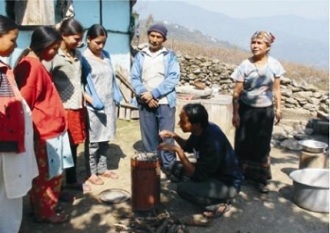In response, the government and many NGOs have distributed “improved” or “clean” stoves that aim to reduce IAP concentrations. For example, the Indian National Programme on Improved Chulhas (NPIC) has distributed over 32 millions improved stoves (as of 2000). The improved stoves can take a variety of forms. They can be made from concrete or mud (concrete lasts longer, but mud is easier to obtain and cheaper, especially in rural areas). Typically, they include a chimney that directs the smoke out of the room. In addition, these stoves usually enclose the cooking flame, which leads to increased efficiency and may potentially reduce wood use.
Despite the popularity of these programs, there is still considerable debate about the benefits of these improved stoves. First do the stoves actually reduce IAP? In the laboratory, we know that the stoves reduce IAP. However, misuse — filling the stoves with too much fuel, not cleaning the chimney properly, not repairing cracks in the stove — may mitigate these gains.




